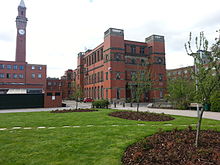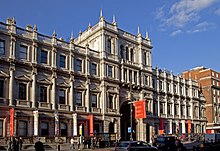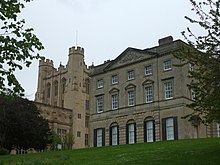MAUD Committee
The MAUD Committee was founded in response to the Frisch–Peierls memorandum, which was written in March 1940 by Rudolf Peierls and Otto Frisch, two physicists who were refugees from Nazi Germany working at the University of Birmingham under the direction of Mark Oliphant.
[13] Frédéric Joliot-Curie and his Paris colleagues Hans von Halban and Lew Kowarski raised the possibility of a nuclear chain reaction in a paper published in Nature in April 1939.
[18] At Cambridge, Nobel Prize in Physics laureates George Paget Thomson and William Lawrence Bragg wanted the government to take urgent action to acquire uranium ore.
In April 1939, he approached Sir Kenneth Pickthorn, the local Member of Parliament, who took their concerns to the Secretary of the Committee for Imperial Defence, Major General Hastings Ismay.
Lord Chartfield, the Minister for Coordination of Defence, checked with the Treasury and Foreign Office, and found that the Belgian Congo uranium was owned by the Union Minière du Haut Katanga company.
Since Union Minière management were friendly towards Britain, it was not considered necessary to immediately acquire the uranium, but Tizard's Committee for the Scientific Survey of Air Warfare (CSSAW) was directed to continue the research into the feasibility of atomic bombs.
[19] Thomson, at Imperial College London, and Mark Oliphant, an Australian physicist at the University of Birmingham, were each tasked with carrying out a series of experiments on uranium.
They also heard from Jacques Allier of the French Deuxième Bureau, who had been involved in the removal of the entire stock of heavy water from Norway.
The original members were Thomson, Chadwick, Cockcroft, Oliphant and Philip Moon; Patrick Blackett, Charles Ellis and Norman Haworth were subsequently added, along with a representative of the Director of Scientific Research at the Ministry of Aircraft Production (MAP).
Even despite their early contributions, Peierls and Frisch were not allowed to participate in the MAUD Committee because, at a time of war, it was considered a security threat to have enemy aliens in charge of a sensitive project.
Its members were: Blackett, Chadwick, Cockcroft, Ellis, Haworth, Franz Simon, Thomson and the Director of Scientific Research at the MAP.
The MAUD Technical Committee's members were: Moses Blackman, Egon Bretscher, Norman Feather, Frisch, Halban, C. H. Johnson, Kowarski, Wilfrid Mann, Moon, Nevill Mott, Oliphant, Peierls and Thomson.
[40] "And so," wrote historian Margaret Gowing, "the greatest of all the wartime secrets was entrusted to scientists excluded for security reasons from other war work.
"[41] The division of the MAUD Committee at Liverpool was led by Chadwick, who was assisted by Frisch, Rotblat, Gerry Pickavance, Maurice Pryce and John Riley Holt.
The division at Liverpool also controlled a small team at the University of Bristol that included Alan Nunn May and Cecil Frank Powell.
[45] By March 1941, Alfred Nier had managed to produce a microscopic amount of pure uranium-235 in the United States, and a team under Merle Tuve at the Carnegie Institution of Washington was measuring the cross section.
As a German émigré, he was only able to get involved after Peierls vouched for him, pointing out that Simon had already begun research on isotope separation, which would give the project a head start by his participation.
[51] The Oxford team was mostly composed of non-British scientists, including Nicholas Kurti, Kurt Mendelssohn, Heinrich Kuhn, Henry Shull Arms and Heinz London.
"We are confident that the separation can be performed in the way described", he concluded, "and we even believe that the scheme is, in view of its object, not unduly expensive of time, money and effort.
[42] On 19 June 1940, following the German invasion of France, Halban, Kowarski and other French scientists and their families, along with their precious stock of heavy water, were brought to England by the Earl of Suffolk and Major Ardale Golding on the steamer Broompark.
The French scientists moved to Cambridge,[57] where they conducted experiments that conclusively showed that a nuclear chain reaction could be produced in a mixture of uranium oxide and heavy water.
[63] A paper was received from the United States in which George Kistiakowsky argued that a nuclear weapon would do very little damage, as most of the energy would be expended heating the surrounding air.
As we proceeded we became more and more convinced that release of atomic energy on a large scale is possible and that conditions can be chosen which would make it a very powerful weapon of war.
A plant to produce one kilogram of uranium-235 per day was estimated to cost £5 million and would require a large skilled labour force that was also needed for other parts of the war effort.
It concluded that the controlled fission of uranium could be used to generate heat energy for use in machines, and provide large quantities of radioisotopes which could be used as substitutes for radium.
In conclusion though, while the nuclear reactor had considerable promise for future peaceful uses, the committee felt that it was not worth considering during the present war.
Sir John Anderson, the Lord President of the Council, became the minister responsible, and Wallace Akers from ICI was appointed the director of Tube Alloys.
[72] The most significant of them at this time was John Cairncross, a member of the notorious Cambridge Five, who worked as the private secretary to Lord Hankey, a minister without portfolio in the War Cabinet.
[85] In response to the 1939 Einstein-Szilard letter, President Franklin D. Roosevelt had created an Advisory Committee on Uranium in October 1939, chaired by Lyman Briggs.
In June 1941, Roosevelt created the Office of Scientific Research and Development (OSRD), with Vannevar Bush as its director, personally responsible to the President.






